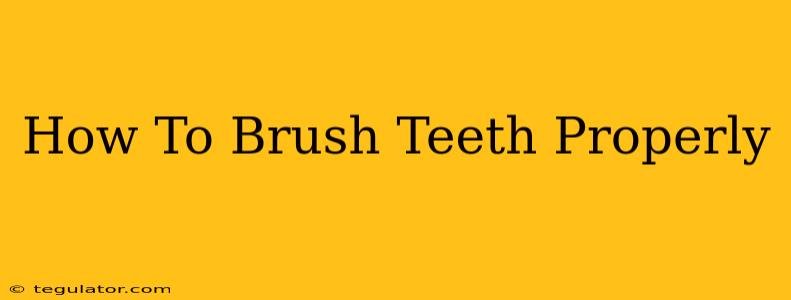Brushing your teeth seems simple enough, right? But are you really getting the most out of your brushing routine? Many people unknowingly make mistakes that can lead to cavities, gum disease, and other oral health problems. This comprehensive guide will teach you how to brush your teeth properly, ensuring a bright, healthy smile for years to come.
The Essential Tools for Proper Teeth Brushing
Before we dive into the technique, let's make sure you have the right tools:
- Soft-bristled toothbrush: Hard bristles can damage your gums and enamel. Opt for a soft-bristled brush that feels gentle on your teeth and gums.
- Fluoride toothpaste: Fluoride strengthens your tooth enamel and protects against cavities. Choose a toothpaste with the American Dental Association (ADA) Seal of Acceptance.
- Dental floss: Brushing alone can't reach all the nooks and crannies between your teeth. Flossing is crucial for removing plaque and food particles from these areas.
The Step-by-Step Guide to Effective Teeth Brushing
Here's the proper technique for brushing your teeth:
-
Wet your toothbrush: Run your toothbrush under warm water to soften the bristles.
-
Apply toothpaste: Squeeze a pea-sized amount of fluoride toothpaste onto your toothbrush.
-
Angle your brush: Hold your toothbrush at a 45-degree angle to your gum line. This allows the bristles to reach under the gum line, where plaque often accumulates.
-
Use gentle, short strokes: Brush back and forth in short strokes, gently moving the brush across each tooth's surface. Avoid scrubbing too hard, as this can damage your gums and enamel.
-
Brush all surfaces: Make sure to brush the outer, inner, and chewing surfaces of each tooth. Don't forget the back of your last molars!
-
Brush your tongue: Gently brush your tongue from back to front to remove bacteria and freshen your breath.
-
Rinse thoroughly: Rinse your mouth thoroughly with water to remove any remaining toothpaste and debris.
How Long Should You Brush?
The American Dental Association recommends brushing your teeth for a full two minutes twice a day, once in the morning and once before bed. Consider using a timer or a toothbrush with a built-in timer to ensure you're brushing for the recommended amount of time.
Choosing the Right Toothbrush
Beyond bristle softness, consider these factors when selecting a toothbrush:
- Brush head size: Choose a brush head that comfortably fits in your mouth and allows you to reach all your teeth.
- Handle design: The handle should be comfortable to grip and easy to maneuver.
- Electric vs. Manual: Both electric and manual toothbrushes can effectively clean your teeth. Electric toothbrushes can be particularly helpful for those with limited dexterity or who struggle to brush thoroughly.
Beyond Brushing: The Importance of Flossing and Regular Dental Checkups
Brushing is a critical part of oral hygiene, but it's not the only thing you need to do to maintain a healthy smile. Flossing at least once a day is essential for removing plaque and food particles from between your teeth. Regular visits to your dentist for professional cleanings and checkups are also crucial for preventing and detecting dental problems early.
Common Brushing Mistakes to Avoid
- Brushing too hard: This can damage your enamel and gums.
- Brushing too quickly: Take your time and ensure you thoroughly clean each tooth surface.
- Ignoring your tongue: Brushing your tongue helps remove bacteria and freshen breath.
- Using the wrong toothpaste: Choose a fluoride toothpaste with the ADA Seal of Acceptance.
- Skipping flossing: Flossing is just as important as brushing.
By following these simple steps and incorporating them into your daily routine, you'll be well on your way to a healthier, brighter smile. Remember, consistent and proper brushing is key to preventing cavities and gum disease, ensuring a lifetime of healthy teeth!

